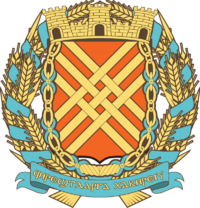National symbols of Vurthungria: Difference between revisions
No edit summary |
|||
| (16 intermediate revisions by the same user not shown) | |||
| Line 5: | Line 5: | ||
! Name !! Symbol !! Introduced !! Notes | ! Name !! Symbol !! Introduced !! Notes | ||
|- | |- | ||
| Constitutional Flag of the Free Association || [[File:Soccies.png|200px]] || 1947 || | | Constitutional Flag of the Free Association || [[File:Soccies.png|200px]] || 1947 || {{small|The sole official national flag of the VFAC, the banner features the Vurthungrian Colors with the nation's Emblem superimposed atop it.}} | ||
|- | |- | ||
| Constitutional Colors of the Free Association || [[File:Vurthtricolore.png|200px]] || 1947 || | | Constitutional Colors of the Free Association || [[File:Vurthtricolore.png|200px]] || 1947<br>{{small|created {{circa}} 1939-40}} || {{small|The constitutional {{wpl|tricolore}} of the Vurthungrian Free Association of Communes displayed without the Emblem. Not officially utilized as a flag on its own, but utilized in a number of ceremonial materials. Additionally, members of the Vurthungrian diaspora abroad have generally taken to utilizing this as their ''de facto'' colors. | ||
<br>The tricolore has multiple interpretations. The gold band represents harvest and plenty for all at the foundation of the society, the high plains of the nation's inland and historically overland culture, and ethnic Vurthungrians. The azure band represents clarity of conscience and reason, the crystal waters of the [[Vordons River]], and the {{wpl|Corsican people|Escolan people}}, members of the [[Aesculia|Aesculian]] diaspora who moved into the area during its occupation by their home empire. The green band represents a sort of permanence and liveliness, indicating that the accomplishments of the revolution will not perish from the world (a nod to the old revolutionary slogan), the vast and largely uncleared [[Tennescosh Forest]] of the North, and the {{wpl|Britons|Innan people}} that settled much of the coast in antiquity and are extremely prominent throughout the coastal regions of the nation.}} | |||
|- | |- | ||
|} | |} | ||
| Line 14: | Line 15: | ||
===Territorial Flags=== | ===Territorial Flags=== | ||
===Military Flags=== | ===Military Flags=== | ||
{|class="wikitable" | |||
! Name !! Symbol !! Introduced !! Notes | |||
|- | |||
| War Flag of the Revolutionary Defense Forces || [[File:Vurthmilstandard.png|200px]] || 1947<br>{{small|created {{circa}} 1943}} || {{small|The Ceremonial War Flag of the [[Vurthungria Revolutionary Defense Forces]]. The earliest variation of this banner reportedly was a defaced war flag of the Vurthungrian National Army in one of the skirmishes between them and the Vurthungria Peoples' Liberation Army in the leadup to the [[Vurthungrian Civil War]]. It follows the traditional style of other Vurthungrian and South Aesculian military flags with a 1:1 ratio, and features the uniform armorial of the VRDF surrounded by a laurel and nine stars, representing the nine year period from the start of the Officers' Coup to the adoption and enforcement of the constitutional government. In each corner, there are four of the Vurthungrian Hourglass symbols similar to the one seen on the Revolutionary Banner of 1939-47. They represent the four organizations which came together to form the united leftist front of the VPLA - the Proletarian Front of the Vordons, Vurthungrian Popular Will Army, Free Peoples Defense League, and the Friends of Liberty.}} | |||
|- | |||
| Naval Jack of the Coastal Defense Forces || [[File:Vurthnaval.png|200px]] || 1947 || {{small|The {{wpl|naval jack}} of the [[Vurthungria Revolutionary Defense Forces|VRDF]] Coastal Defense Forces. A black saltire with four trangles composed of the Vurthungrian national colors overlapping within each other. Roughly based on the {{wpl|International Code of Signals}} flags Mike and Whiskey, representing the term ''"Marrheweg"'', or Sea Defense, the [[Vurthungrian language|Vurthungrian]] term for the forces. | |||
|} | |||
===Historical Flags=== | ===Historical Flags=== | ||
{|class="wikitable" | {|class="wikitable" | ||
! Name !! Symbol !! Used !! Notes | ! Name !! Symbol !! Used !! Notes | ||
|- | |- | ||
| Revolutionary "Hourglass Banner" || [[File:Vurthrevolt.png|200px]] || 1939-1947 || | | Revolutionary "Hourglass Banner" || [[File:Vurthrevolt.png|200px]] || {{circa}} 1939-1947 || {{small|The main banner utilized by the early [[Vurthungrian Unified Free Defense Forces|Black Army]] and pre-Constitutional [[Free Territory of Vurthungria|Black Vurthungria]]. The main symbol is an hourglass, to denote the inevitable victory of the working class, and the phrase is "This fire within all men shall not perish from this land" {{small|([[Vurthungrian Language|''Aesculized Vurthungrian'']]: ''"As'ansá oghánas sciw nid darman"'')}}. The two stars represents the two "great revolutions" in the nation's modern history - the first, the War of Independence in 1903 which ended its period as a province of a nearby empire, and the second, the struggle to dismantle the dictatorship of the bourgeoise as part of the Vurthungrian Revolution of 1939-43. Today, this flag is only utilized on official basis in celebrations of the Revolution and major events which occurred prior to the adoption of the Free Association's Revolutionary Constitution in 1947, though elements introduced in this banner are still seen in many official symbols of the Free Association.}} | ||
|- | |- | ||
|} | |} | ||
==Seals== | ==Seals== | ||
{{Infobox coat of arms | {{Infobox coat of arms | ||
|color = #000000 | |color = #000000 | ||
|name = Emblem of the | |name = Emblem of the Free Association of Communes | ||
|image = File:Vurthcoa.png | |image = File:Vurthcoa.png | ||
|image_width = 300 | |image_width = 300 | ||
| Line 36: | Line 44: | ||
|supporters = Sheaves of {{wpl|White Winter Wheat}} adorned by black ribbons bearing the Vurthungrian Tricolor on its obverse. | |supporters = Sheaves of {{wpl|White Winter Wheat}} adorned by black ribbons bearing the Vurthungrian Tricolor on its obverse. | ||
|compartment = | |compartment = | ||
|motto = | |motto = 1903, 1947 | ||
|orders = | |orders = | ||
|other_elements = | |other_elements = | ||
| Line 42: | Line 50: | ||
|use = | |use = | ||
|notes = | |notes = | ||
}} | |||
===Emblem of the Free Association of Communes=== | |||
The Emblem of the Free Association of Communes is the {{wpl|coat of arms}} of Vurthungria. The current iteration was adopted in 1947 following the establishment of the Constitution and the subsequent major governmental reorganization. It is considered an example of {{wpl|socialist heraldry}}. The {{wpl|blazon}} is rooted in a combination of three seals which were commonly utilized by the three major revolutionary organizations that arose during the early phases of decline of the [[Grand Principality of Vurthungria|Grand Principality]] - the lighthouse, hammer and pick, and drafting compass corresponding to Progressive Society, Lendemores, and Party for Reason and Reform, respectively. | |||
The official description of the Emblem is as follows: | |||
{{quote|''The national emblem of the Vurthungrian Free Association of Communes will include the facade of a traditional Innan-style lighthouse, a pick and hammer, drafting compass, and cogwheel in sable on azure, representing the harmonious cooperation of the trades which form the foundation of the Vurthungrian revolutionary society. It will be surrounded by a laurel of white winter wheat, the nation's historic grain, which itself will be adorned with a scroll bearing the constitutional colors, and a black inverse which bears the years of the two Great Revolutions of the 20th Century - the first in 1903 which dismantled imperial subjugation, and 1947, in which the threat of the bourgeois dictatorship was finally and completely removed from the land. A black star will sit atop the seal, in representation of the five ineffable aims of the revolution.''<br>{{small|[[Revolutionary Constitution of Vurthungria]], Section 8: Official Symbols of the Free Association}} | |||
}} | }} | ||
===National Seals=== | ===National Seals=== | ||
| Line 54: | Line 68: | ||
====National Anthem==== | ====National Anthem==== | ||
===Art=== | ===Art=== | ||
==Structures== | |||
{|class="wikitable" | |||
! Name !! Image !! Location !! Completed !! Notes | |||
|- | |||
| Constitution House || [[File:Vilnius_Seimas.jpg|200px]] || [[Taradabourgh]] Pancommunal Cooperation District || 1975 || {{small|Current seat of the [[Federal Revolutionary Commissary of Vurthungria]] and {{wpl|seat of government}} of the VFAC on a national level, completed in 1975 as part of the development of the planned capital of [[Taradabourgh]], which subsequently replaced the chronically-congested [[New Haim]] in December 1976 following the elections of that year.}} | |||
|- | |||
| Old Hoylend Light || [[File:Hoy_Lighthouse_RLH.jpg|200px]] || || 1848 || {{small|One of the first modern lighthouses built by Vurthungrians, located on the mouth of Hoylend Bay, one of the nation's most vital historic ports. Featured on the blazon of the Revolutionary Seal and regarded as a major piece of cultural archetecture of the Vordono-Innans. It is currently the longest-maintained electric lighthouse in the VFAC}} | |||
|- | |||
| Old Union House || [[File:Gamla_Riksdagshuset_Sthlm_sjösida.jpg|200px]] || [[New Haim]] || 1862 || {{small|Historic building which was the original meeting place for the members and leadership of the Vurthungrian Peoples' Liberation Army during the [[Vurthungrian Civil War]], and served as the home of the [[Executive Commission of Vurthungria|Executive Commission]] from its inception in 1943 until relocation to [[Taradabourgh]] in 1976 following its instatement as the new national capital, replacing New Haim. It currently acts as a museum of the [[Vurthungrian Revolution]] and Civil War and is a regional headquarters for the Vurthungria Historical Society.}} | |||
|- | |||
|} | |||
{{Vurthungria}} | |||
Latest revision as of 20:13, 5 February 2020
Included in this article is a selection of various symbols of Vurthungria, its government, culture, military, people, and historical entities associated with the modern nation.
Flags
National Flags
| Name | Symbol | Introduced | Notes |
|---|---|---|---|
| Constitutional Flag of the Free Association | 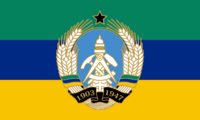 |
1947 | The sole official national flag of the VFAC, the banner features the Vurthungrian Colors with the nation's Emblem superimposed atop it. |
| Constitutional Colors of the Free Association |  |
1947 created c. 1939-40 |
The constitutional tricolore of the Vurthungrian Free Association of Communes displayed without the Emblem. Not officially utilized as a flag on its own, but utilized in a number of ceremonial materials. Additionally, members of the Vurthungrian diaspora abroad have generally taken to utilizing this as their de facto colors.
|
Regional and Municipal Flags
Territorial Flags
Military Flags
| Name | Symbol | Introduced | Notes |
|---|---|---|---|
| War Flag of the Revolutionary Defense Forces | 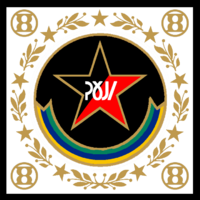 |
1947 created c. 1943 |
The Ceremonial War Flag of the Vurthungria Revolutionary Defense Forces. The earliest variation of this banner reportedly was a defaced war flag of the Vurthungrian National Army in one of the skirmishes between them and the Vurthungria Peoples' Liberation Army in the leadup to the Vurthungrian Civil War. It follows the traditional style of other Vurthungrian and South Aesculian military flags with a 1:1 ratio, and features the uniform armorial of the VRDF surrounded by a laurel and nine stars, representing the nine year period from the start of the Officers' Coup to the adoption and enforcement of the constitutional government. In each corner, there are four of the Vurthungrian Hourglass symbols similar to the one seen on the Revolutionary Banner of 1939-47. They represent the four organizations which came together to form the united leftist front of the VPLA - the Proletarian Front of the Vordons, Vurthungrian Popular Will Army, Free Peoples Defense League, and the Friends of Liberty. |
| Naval Jack of the Coastal Defense Forces | 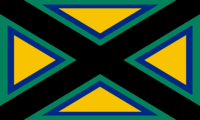 |
1947 | The naval jack of the VRDF Coastal Defense Forces. A black saltire with four trangles composed of the Vurthungrian national colors overlapping within each other. Roughly based on the International Code of Signals flags Mike and Whiskey, representing the term "Marrheweg", or Sea Defense, the Vurthungrian term for the forces. |
Historical Flags
| Name | Symbol | Used | Notes |
|---|---|---|---|
| Revolutionary "Hourglass Banner" | 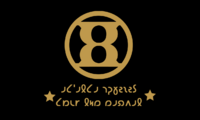 |
c. 1939-1947 | The main banner utilized by the early Black Army and pre-Constitutional Black Vurthungria. The main symbol is an hourglass, to denote the inevitable victory of the working class, and the phrase is "This fire within all men shall not perish from this land" (Aesculized Vurthungrian: "As'ansá oghánas sciw nid darman"). The two stars represents the two "great revolutions" in the nation's modern history - the first, the War of Independence in 1903 which ended its period as a province of a nearby empire, and the second, the struggle to dismantle the dictatorship of the bourgeoise as part of the Vurthungrian Revolution of 1939-43. Today, this flag is only utilized on official basis in celebrations of the Revolution and major events which occurred prior to the adoption of the Free Association's Revolutionary Constitution in 1947, though elements introduced in this banner are still seen in many official symbols of the Free Association. |
Seals
| Emblem of the Free Association of Communes | |
|---|---|
 | |
| Armiger | Vurthungrian Free Association of Communes |
| Adopted | 1947 |
| Crest | Black five-pointed star |
| Blazon | Traditional innan lighthouse superimposed by a crossed hammer and mining pick and a drafting compass |
| Supporters | Sheaves of White Winter Wheat adorned by black ribbons bearing the Vurthungrian Tricolor on its obverse. |
| Motto | 1903, 1947 |
Emblem of the Free Association of Communes
The Emblem of the Free Association of Communes is the coat of arms of Vurthungria. The current iteration was adopted in 1947 following the establishment of the Constitution and the subsequent major governmental reorganization. It is considered an example of socialist heraldry. The blazon is rooted in a combination of three seals which were commonly utilized by the three major revolutionary organizations that arose during the early phases of decline of the Grand Principality - the lighthouse, hammer and pick, and drafting compass corresponding to Progressive Society, Lendemores, and Party for Reason and Reform, respectively.
The official description of the Emblem is as follows:
The national emblem of the Vurthungrian Free Association of Communes will include the facade of a traditional Innan-style lighthouse, a pick and hammer, drafting compass, and cogwheel in sable on azure, representing the harmonious cooperation of the trades which form the foundation of the Vurthungrian revolutionary society. It will be surrounded by a laurel of white winter wheat, the nation's historic grain, which itself will be adorned with a scroll bearing the constitutional colors, and a black inverse which bears the years of the two Great Revolutions of the 20th Century - the first in 1903 which dismantled imperial subjugation, and 1947, in which the threat of the bourgeois dictatorship was finally and completely removed from the land. A black star will sit atop the seal, in representation of the five ineffable aims of the revolution.
Revolutionary Constitution of Vurthungria, Section 8: Official Symbols of the Free Association
National Seals
Regional and Municipal Seals
Historical Seals
Flora and Fauna
Food and Drink
Media
Literature
Music
National Anthem
Art
Structures
| Name | Image | Location | Completed | Notes |
|---|---|---|---|---|
| Constitution House | File:Vilnius Seimas.jpg | Taradabourgh Pancommunal Cooperation District | 1975 | Current seat of the Federal Revolutionary Commissary of Vurthungria and seat of government of the VFAC on a national level, completed in 1975 as part of the development of the planned capital of Taradabourgh, which subsequently replaced the chronically-congested New Haim in December 1976 following the elections of that year. |
| Old Hoylend Light |  |
1848 | One of the first modern lighthouses built by Vurthungrians, located on the mouth of Hoylend Bay, one of the nation's most vital historic ports. Featured on the blazon of the Revolutionary Seal and regarded as a major piece of cultural archetecture of the Vordono-Innans. It is currently the longest-maintained electric lighthouse in the VFAC | |
| Old Union House |  |
New Haim | 1862 | Historic building which was the original meeting place for the members and leadership of the Vurthungrian Peoples' Liberation Army during the Vurthungrian Civil War, and served as the home of the Executive Commission from its inception in 1943 until relocation to Taradabourgh in 1976 following its instatement as the new national capital, replacing New Haim. It currently acts as a museum of the Vurthungrian Revolution and Civil War and is a regional headquarters for the Vurthungria Historical Society. |
